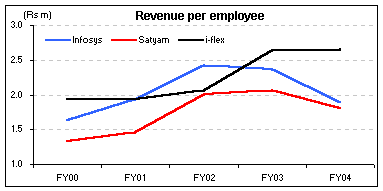
Home > Business > Business Headline > Report
Software products: Next step?
June 24, 2004 07:15 IST
Raising salary levels has been one of the foremost initiatives taken by Indian software companies to ward-off rising competition for talent from MNC technology companies. Be it the second-largest software and services company, Infosys, or the largest provider of software products to the banking industry, i-flex, all have faced tremendous degree of pressure on their bottomlines due to the rise in employee costs during the past few years. As indicated in the graphs above, cost per employee for software services firms, Infosys and Satyam have risen incessantly for the period FY00-FY03, only to fall marginally during FY04. However, not much should be read into this fall in cost per employee in FY04, as this was more a result of a substantial rise in the employee base (the denominator) than a fall in total employee costs (the numerator). For instance, in FY04, the number of employees for Infosys and Satyam grew YoY by 67 per cent and 44 per cent respectively. On the other hand, employee costs for the same period have increased at lower rates of 47 per cent and 37 per cent respectively. This slower rise in employee costs can be attributed to the fact that both these companies have hired a lot many freshers (with marginal or no experience) who come at lower incremental costs. Now, when we compare these figures to that of i-flex, which is largely involved into software products (61 per cent of FY04 revenues), cost per employee has risen in FY04 mainly due to the fact that the company saw a 67 per cent rise in its employee costs, while growth in its employee base was relatively sedate at 28 per cent YoY. This is indicative of the fact that, i-flex, being a relatively small company, will have to bear a greater pressure on its profitability than, say Infosys. Coming out of a regulation that barred its penetration into the US markets, i-flex is now spending heavily on setting up selling and marketing teams in that region, and this is putting a great deal of pressure on its bottomline. Employee costs as per cent of revenues, which are although lower for i-flex, are rising faster than the software services majors (see above graphs).  That was on the cost front. Coming to the revenue per employee comparison, the above graph indicates that this figure for Infosys and Satyam have fallen during FY04, again due to a rapid expansion to the employee base. On the contrary, the figure for i-flex has been on a rise since FY02. The very fact that i-flex generates a majority of revenues from Flexcube, its core-banking product, has helped the company to earn higher incremental revenues per employee added. More simply, since product is not a linear business (where you earn more by putting more people to work, like in case of Infosys and Satyam), the revenue per employee for i-flex has risen as compared to the software services majors. What needs to be done? In the software services business, Indian companies historically have had a cost advantage over their Western competitors in markets like the US and Europe. However, the downturn in the US economy has forced these companies to trim billing rates to compete with Indian software companies. Since reducing billing rates became the foremost imperative, MNC tech companies started setting up bases in India in order to reduce costs. This has not only threatened Indian IT industry's cost leadership, Indian software companies have also been made to face intense competition for talent. All these pressures mean lower or stagnant billing rates and higher employee costs going forward. This is likely to have a serious impact on the operating margins of software services companies like Infosys and Satyam and, consequently, their profitability. Now, to pare the pressure arising due to the abovementioned factors, what Indian software companies are doing is moving rapidly up the value chain and providing high-end services. Apart from this, Indian companies have embarked on a rapid expansion of employee base, in order to garner higher volumes. However, initiatives on the products front seem to be lacking pace. It must be noted that, apart from being at the higher end of the value chain, products help in paring margin pressure as revenues from them flow straight to the bottomline after the recovery of costs incurred to produce them, brand them and sell them. Except i-flex, there is no other Indian software company that has made a mark in the global arena through its product offerings. Aggressiveness on the products front may be the need of the hour for Indian software companies, as it will help them reduce pressure on the margins front and also help them in improving employee productivity. Equitymaster.com is one of India's premier finance portals. The web site offers a user-friendly portfolio tracker, a weekly buy/sell recommendation service and research reports on India's top companies.
|